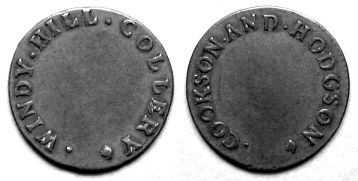
THE TOKENS OF THE WINDY HILL COLLIERY, GREYSOUTHEN, CUMBERLAND, AND OTHER NEARBY PITS.
The location of the Windy Hill Colliery, for which the partnership of Cookson and Hodgson issued a copper token, (Fig.1), has hitherto been a matter of conjecture. An example of the token, from the Norman Brodie Collection of Scottish tokens, was sold recently at a London auction,(1) where it was attributed to Renwfrewshire, Scotland, with a note of the location of the pit: “Windyhill pit 42 fathoms in depth and part of the Hurlet seam, was located between Windyhill and West Fulton.”

Fig. 1 Windy Hill Collery (sic) Greysouthen, Cumberland, pre 1781, Cu Token, 25.54 mm, 5.7 g. (Davis & Waters 165 - Tickets and Passes of Great Britain and Ireland. 1922. Hereafter D&W).
This attribution was based on a reference to a Windyhill Pit near Johnstone in Renfrewshire.(2) It will be the main purpose of this article to show that the Windy Hill Colliery for which the Cookson and Hodgson token was issued, was in fact situated on the Greysouthen side of the River Marron, in the Parish of Brigham, West Cumberland, near Little and Great Clifton, where the Cooksons also had pits.
The author first encountered the Cookson family, of whom several were metalworkers, while researching the pewterers of Penrith, in 1985.(3) In particular, William Cookson, (1668-1744), of Penrith, one of no less than three of the same name working in that town as braziers in the late 17th century, was probably also the pewterer whose mark is found on several fine flagons and alms dishes in a number of local churches (Fig. 2).
Fig. 2 William Cookson's peweter's touch mark and "hallmarks", c.1695.
In his will of 1744, proved in 1745, he bequeathed to Joseph Bowes, his son-in-law, the husband of his daughter Sarah, his one-eighth shares in his Iron Foundries at Newcastle-upon-Tyne, furnaces and a water-driven corn mill at Clifton Fields and a Colliery at Clifton, which he owned in partnership with his nephew John Cookson, Mr John Williams, both Newcastle merchants, and others.(4) John Cookson, (d.1783), was the eldest son of William’s brother Isaac, (1678-1743), also a Newcastle merchant, who prior to his death had been a partner in the various concerns mentioned. John Williams died in 1744.
On 16th September, 1721, William (of Penrith) and his younger brother Isaac (of Newcastle), had together acquired from Ruth Kendall, widow, and Adam Kendall, yeoman, of Crookborrow, Cumberland, a close of land called Highfield at Little Clifton, and built there “a furnace and several workhouses and stables, and made dams and watercourses for carrying on an iron foundry”. A letter from his agent John Spedding to James Lowther, of 30th August, 1723, says: “A work like you mention is now Erecting by Mr. Cookson at Brigfoot. He proposes to use pitt Coal in Smelting the Iron stone, and thinks to have his work forward by Christmas.”(5)
The “furnace”, or iron foundry, was situated on the River Marron, which supplied the necessary water power; ironstone was obtained from Branthwaite, and the coal from the Cooksons’ mines at Clifton and Greysouthen.(6) The site is shown on Thomas Donald’s map of Cumberland, 1774.(7)
The Cooksons of Newcastle were also partners in many other industrial and commercial enterprises, including iron foundries in Newcastle and Gateshead, Glassworks in County Durham, South Shields and elsewhere and the Newcastle Bank, the first provincial bank in England. William Cookson of Penrith’s eldest son John was a London merchant, while his second son Isaac, (no doubt named after his father’s brother), became a noted silversmith in Newcastle. The John Cookson named in the will of 1744, William’s nephew, died in 1783, leaving his interests in the Greysouthen concerns to his son, another Isaac, (1745-1831).(8) By this time, the Windy Hill Pit had already closed, but a document, undated, circa 1785,(9) listing the real estate of “the late John Cookson, Esq., in partnership with the late John Hodgson, Esq., in the Township of Greysouthen”, has references to an attached plan of the Windy Hill Estate, (Fig.17), which clearly shows the positions of the Windy Hill Colliery, the unnamed furnace buildings on the opposite, (Little Clifton), bank of the River Marron and the corn mill. A second Plan attached, shows the Little Clifton side of the Marron, and names the same buildings as the Clifton Furnace.(10) There can be no doubt that the John Cookson and John Hodgson referred to in this document are the partners named on the Windy Hill Colliery token.
The Windy Hill Estate plan also shows another colliery belonging to the Cookson and Hodgson partnership, the Greysouthen Colliery, with its own engine, a little further upstream on the River Marron to the south of the Workington/Cockermouth turnpike road. Another piece of land belonging to the Cookson partnership is indicated on the Little Clifton side of the river, near the Clifton Furnace, and adjoining the Beerpot Colliery. The plan also enumerates properties in the possession of Isaac Cookson, Esq., “purchased since 1774” and mentions land purchased from Miss Bowes, which may be part of that inherited by William Bowes from his father-in-law William Cookson, in 1744. At this time, the mid 1780s, William Bowes still owned the Corn Mill. A further document of the same archive gives him as the owner of Greysouthen Corn Mill, “bought on 1 Dec 1741”. The purchase was presumably with the assistance of William Cookson and other members of the family, in one-eighth shares. (11)
The productions of the Clifton Furnace are indicated in another document from the same archive, which, after a preamble referring to another Cookson pit(12) in the Manor of Great and Little Clifton, “a very good Colliery carrying on in the Wastes of the sd Mannor which are very large & extensive & full of Coal”, goes on “there is a great Quantity of Iron Oar & Ironstone in the said Wastes, And what is most remarkable the Iron Oar is fluxed & smelted intirely with the Coal got there without the least mixture of Char Coal and this is the only Coal in Europe yet found out so free from Sulphur as to be able to be made Use of for the making of Iron.” ... And “(they) are now carrying on to a very great Proffit for the casting and making of Iron Potts & other Utensils of Cast Iron.”(13) It would seem that the foundry also cast the iron carriages for the cannon shipped to Whitehaven to replace those hurriedly sent to Carlisle to assist in the city’s defences against the army of Prince Charles Edward Stuart, in the Jacobite Rebellion of 1745.(14)
The Colliery referred to, in Great and Little Clifton, was that which had been worked in the early years of the 18th century by Thomas Salkeld, on his own land, until 1726. A token in the baroque style of the first half of the eighteenth century, with an armorial of an heraldic fret and crest a demi-dragon segreant, the reverse with cypher MS, may or may not be connected. (Fig. 3) The Whitehall, Cumberland, branch of the Salkeld family, which, according to Ferguson, (D. & W. 117), worked coal at an early period near Whitehall, bore arms Vert a fret Or, and a demi-dragon segreant crest, but a male member of the family with a christian name beginning with ‘M’ has not be traced.(15)
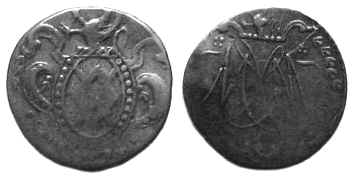
Fig. 3 Copper token with arms which may be those of Salkeld, the reverse with the cypher MS, Cu 23.34 mm, 2.8 g. (D&W - 117).
Normally, male arms would be displayed on a shield and female on a lozenge. The use of an oval is somewhat unusual, and may therefore represent either. If the oval is seen, perhaps, in place of a lozenge, the arms may be those of Margaret Salkeld, (widow of Dr. Henry Salkeld, [d.1749], the last male of the Whitehall branch of the family,) who owned the estate until her own death in 1769, when it passed into the Charlton family.
During the period of her widowhood, the pit was worked, as lessees, by the Cooksons and their partners, but it may have been that tokens were needed for the movement of any coal supplied by them to their lessor, which would naturally use her arms and cypher. The fact that the fret itself incorporates a lozenge form would no doubt make the use of a lozenge for the whole arms somewhat repetitive in design, which may have been the reason for this contrasting oval form, with the addition of the rather feminine embellishment of an ornamental edge. Both the pure baroque style of the scrollwork mantling of the armorial and the cypher itself, with no trace of the rococo, would suggest that the manufacture of these tokens, if they are indeed hers, would date from the start of Margaret Salkeld’s widowhood in 1749, rather than later.
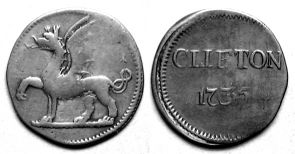
Fig. 4 Clifton Token, 1735, with crest of Lowther, Cu 26.25 mm, 6.1 g. (D&W - 34).
In 1726, Thomas Salkeld leased the pit to John Porter of Workington, for nine years.(16) On the expiry of this lease, the colliery was, on 24th March, 1734, leased by the Cookson and Williams partnership, owners of the Clifton Furnace, for 21 years at a rent of £250 per annum. Two days later, on 26th March, they entered into an agreement to supply Sir James Lowther and Walter Lutwidge, Esq., with 7,000 tons of coal annually for the term of the lease, delivered to Workington Harbour.17 It has been very reasonably suggested that the Clifton tokens of 1735 were probably issued by Sir James Lowther, for this purpose. They are found in both copper and brass, the latter counter-marked with a barred L, possibly to distinguish the Lowther and Lutwidge shares of such movements.(18) (Figs. 4 and 5)
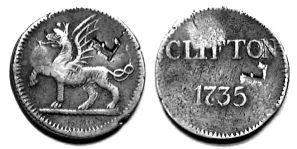
Fig. 5 Clifton Token, 1735, with crest of Lowther and countermarked L, perhaps for Lutwidge, Brass, 25.15 mm, 5.2 g. ( D&W - 37).
The Cooksons had shown their business acumen and foresightedness in the setting up of their various Clifton and Greysouthen enterprises. They could not, however foresee the event, in 1781, which was to bring about the demise of their colliery. In spite of their having their own “Fire Engines”, as steam pumping engines were then called, and which are also shown on the Windy Hill Estate Plan at both the Windy Hill and Greysouthen pits, the workings were inundated when Sir James Lowther closed down his neighbouring collieries and the water which had been raised by his engines entered their colliery, forcing its untimely closure.(19)
In 1787, William Walker & Company leased the coal under a considerable portion of Greysouthen, and they and their successors carried on an extensive and profitable business for the following eighty years. In 1800, another firm, Wilson & Company, opened a new colliery in the same township.(20) One of these two firms, (probably the earlier, from the style of the engraving), is likely to have been responsible for the issue of the Graysouthen tokens of which several varieties are known, mostly with the cypher W & Co on the reverse. (Figs. 6 to 11). The numerals probably stand for bushels, but the significance of the H counter-marks and cut gussets is unclear.
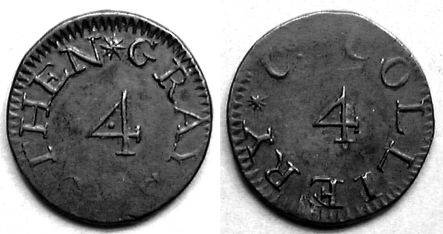
Fig. 6 Graysouthen Colliery, Cu 26.52 mm, 8.9 g (D&W - 82).
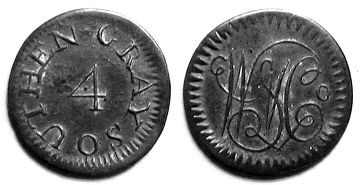
Fig. 7 Graysouthen Colliery, Cu 28.72 mm, 7.9 g (D&W - 84).

Fig. 8 Graysouthen Colliery, Cu 29.56 mm, 7.7 g (D&W - 85), counter-marked with stamped 7 / H.
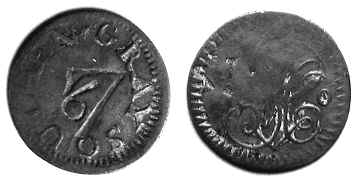
Fig. 9 Graysouthen Colliery, Cu 28.43 mm, 5.3 g, counter-marked with stamped 7 and 6 / H.
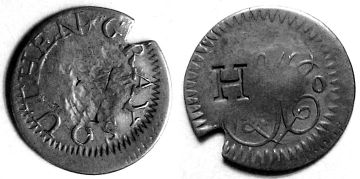
Fig. 10 Graysouthen Colliery, Cu 30.23 mm, 7.9 g, counter-marked with engraved 7 / stamped H, with cut gusset.
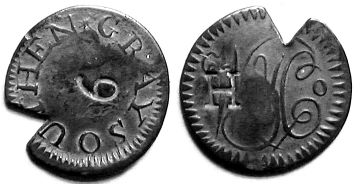
Fig. 11 Graysouthen Colliery, Cu 28.97 mm, 6.8 g, counter-marked with stamped 6 / H, with cut gusset.
It will be seen from the Windy Hill Estate plan, that the immediate neighbours of the Greysouthen colliery at the time of its ownership by the Cookson and Hodgson partnership, were Joseph Harris and Peter Wilson. If this Wilson, as seems possible, was a forbear of the Wilson who opened his colliery there in 1800, then the W & Co cypher might possibly represent a partnership of Peter Wilson, Joseph Harris and possibly others, and the H might then stand for Harris. But this, at present, is pure speculation.
In 1823, Joseph Birbeck and J.W. Fletcher began operations in Greysouthen, when they leased a royalty on Curwen land for nine years at a yearly rent of £20 and one shilling per ton above an annual output of 400 tons.(21) They also issued a token (Fig. 12), as did the partnership of Harris and Fawcett, with a fine representation of an atmospheric engine on the obverse (Fig.13).
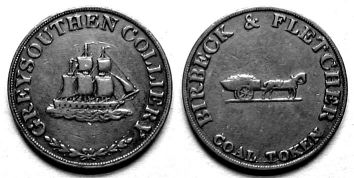
Fig. 12 Greysouthen Colliery, Birbeck & Fletcher, Cu 30.37 mm, 11.4 g. (D&W - 86).
It will be seen from the estate plan, (Fig. 16) that Joseph Harris was in possession of several properties adjoining the Cookson & Company mine at Greysouthen, before 1785. Joseph Harris and Company worked a number of pits there, which by 1816 produced some 10,000 waggons of coal annually. It is probable that the Fawcett of the token was one Richard Fawcett, who mined coal elsewhere, at Dean, from 1774, and near Wigton, where the firm of Crosthwaite, Fawcett & Co., took a lease in 1779 and renewed it for 21 years in 1810.(22)
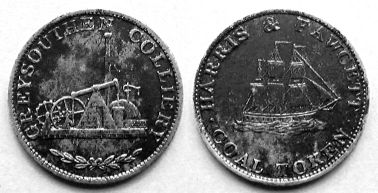
Fig. 13 Greysouthen Colliery, Harris & Fawcett, Brass 28.76 mm, 9.1 g. (D&W - 88).
A token which has hitherto eluded a satisfactory explanation is that of the Bank Land Colliery, some four miles from Clifton, on the eastern side of Workington, which has, on the obverse an armorial ermine a lion rampant with a crest a griffin’s head erased, and on the reverse a cypher formed of a cursive G and the same reversed, with date 1760. (Fig. 14) A variety has four ermine tails, (referred to by D. and W. as arrowheads), on the reverse field. (Fig.15) A further variety has the ermine tails of the reverse inverted and the obverse legend at 180º. (Fig. 16)
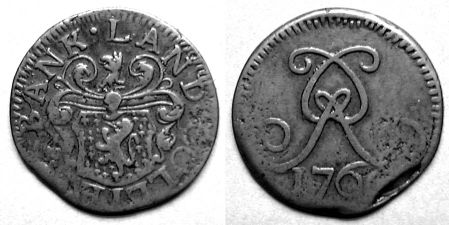
Fig. 14 Bank Land Colliery token, 1760, Cu 27.9 mm, 6.8 g. (D&W - 10).
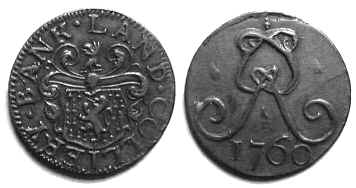
Fig. 15 Bank Land Colliery token, 1760, Cu 27.58 mm, 8.3 g. (D&W - 8).
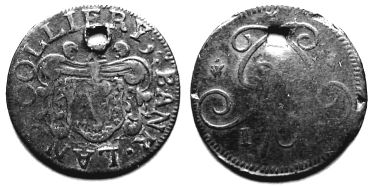
Fig. 16 Bank Land Colliery token, 1760, Cu 28.29 mm, 7.6 g.
Because of the lack of tinctures on the token, Ferguson attributed the arms and crest to the Pickering family who bore arms Ermine a lion rampant Azure crowned. No crest had previously been recorded for that family.(23) He was, however, at a loss to account for the use of the Pickering arms on a token of this date as the Pickering estates in Cumberland had been sold prior to 1582, nor for the cypher GG.
The arms are in fact those of a Whitehaven merchant, Gabriel Griffith, a connection of the Cooksons. William Cookson, (who, as we have seen, owned a share of the Clifton Colliery and Furnace in 1744), had a younger brother, Thomas Cookson, merchant, of Penrith, (1676-1721), whose daughter Ann married Gabriel Griffith, of Whitehaven, at Newton Reigny, Cumberland, in 1740.(24) He was the third son of Gabriel Griffith, Master Gunner at Carlisle Castle, (d.1750), and his wife Grace, daughter of Richard Eaglesfield of Allerby. The Griffith arms are Ermine a lion rampant Sable,(25) and their crest a griffin’s head erased.(26) In the year following that of his Bank Land token, Gabriel Griffith leased a colliery at Dean, a few miles south of Clifton, but by 1766 he was, unfortunately, bankrupt.(27)
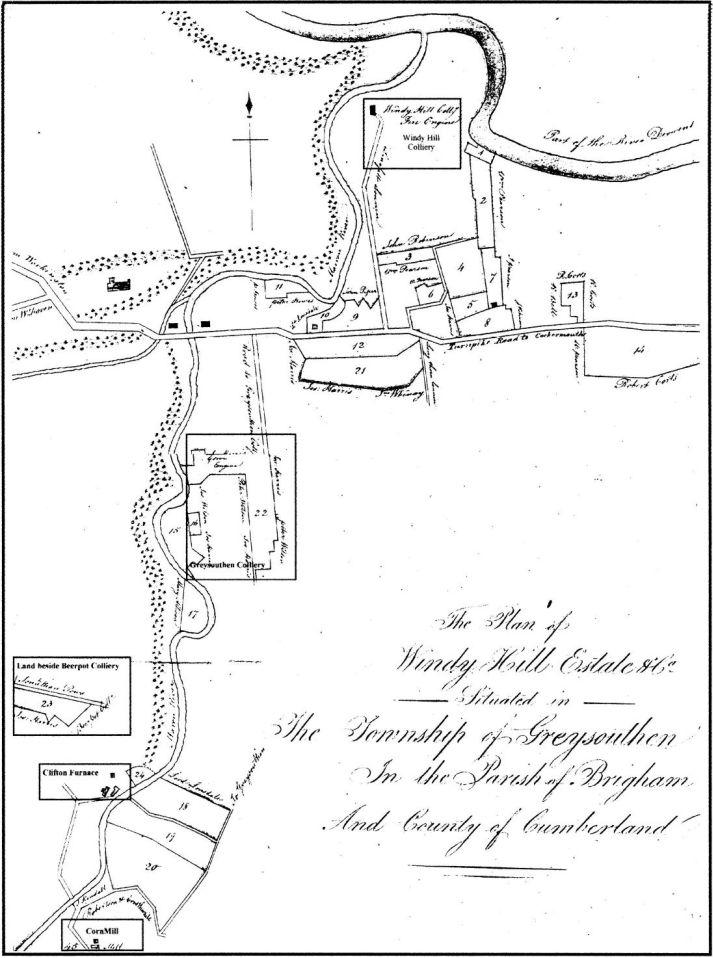
Fig. 17 The Windy Hill Estate, Greysouthen (Boxes highlighting Cookson enterprises added). © Lowther Estates. Ref: CRO Carlisle D/Lons/W8/9/8.
Footnotes:
Dix Noonan Webb, Sale 8th October, 2002, Lot 391. It realised £80.00 (hammer price).
The Economic Geology of the Central Coalfield of Scotland, Area IV, Paisley, Johnstone and Glasgow, H.M.S.O., 1920, p.32.
Finlay, Michael, The Pewterers of Penrith, Transactions of the Cumberland and Westmorland Antiquarian and Archaeological Society, New Series, Vol. LXXXV, 1985, Article XVI
Cumbria Record Office, Carlisle, P.1745.
Hedley, W. Percy, M.A., F.S.A., and Hudleston, C. Roy, M.A., F.S.A., Cookson of Penrith, Cumberland, and Newcastle on Tyne, privately printed, 1968, quoting from Lowther papers.
Wood, Oliver, West Cumberland Coal, 1600-1982/3, C.W.A.A.S. Extra Series Vol. XXIV, 1988, p.32.
Republished as C.W.A.A.S. Record Series, Vol. XV, 2002.
Hedley and Hudleston, op. cit., p.25.
This plan can not date from before 1784, when Sir James Lowther, was elevated to the peerage as Earl of Lonsdale. His name appears as adjoining landowner to Cookson holdings, numbered 10 and 18, as Lord Lonsdale.
C.R.O. Carlisle, part of a large quantity of documents, unlisted, in D/Lons/W8/9/8, (Box 1075)
Idem, part of Box 1075.
The colliery referred to here is that for which the Cooksons took a Lease for 21 years, in 1735, on Salkeld land in Great and Little Clifton, previously leased by John Porter of Workington.
D/Lons/W8/9/8, part of Box 1075, “Particular of the Mannors of Clifton and Graysouthen propos’d to be sold under the Decree of Chancery of the 14th February, 1750”.
C.R.O. Carlisle. An index card to a box of documents which include the details of the shipment of these cannon, refers to their iron carriages, “cast at Clifton Furnace”. There is a large number of boxes awaiting calendaring, and the document itself appears to have been temporarily misplaced.
Hudleston, C. Roy, Boumphrey, R.S. and Hughes, J., Cumberland Families and Heraldry, C.W.A.A.S. Extra Series, Vol. XXIII, 1978.
Kennett, Bill, West Cumberland Carriers Tokens – Part 1 The Earliest, in The Token Corresponding Society Bulletin, Vol. 6, Number 7, for a token issued with the counter-mark of John Porter, possibly for this pit.
Vide 12 above, “Particulars, etc…….”
Kennett, Bill, op.cit.
Fletcher, Isaac, M.P., F.R.S., The Archaeology of the West Cumberland Coal Trade, C.W.A.A.S., Old Series, Vol. III, (1878), Article XXVII, p. 298.
Ibid, p.301.
Wood, Oliver, op.cit, p.124
Ibid, pp. 77 and 82
Hudleston and Boumphrey, op. cit., p.262.
Hedley and Hudleston, , op. cit., Cookson pedigree, table 2.
Hudleston and Boumphrey, op. cit., p.141.
Fairbairn, James, Fairbairn’s Crests of the Families of Great Britain and Ireland, 1986, p.217.
Wood, Oliver, op.cit., p.76
Acknowledgements:
I am indebted to the Earl of Lonsdale for the use of documents in the Lowther archive, and for his generous permission to publish extracts from them, to the ever-helpful Staff of Cumbria Record Office Carlisle, and to Norman Brodie, Esq., who kindly provided Reference 2. Photographs are by the author from tokens in his own collection. My thanks to Ken Carruthers of Great Clifton and to Rob Dixon for an interesting visit to the site of the Windy Hill pit.